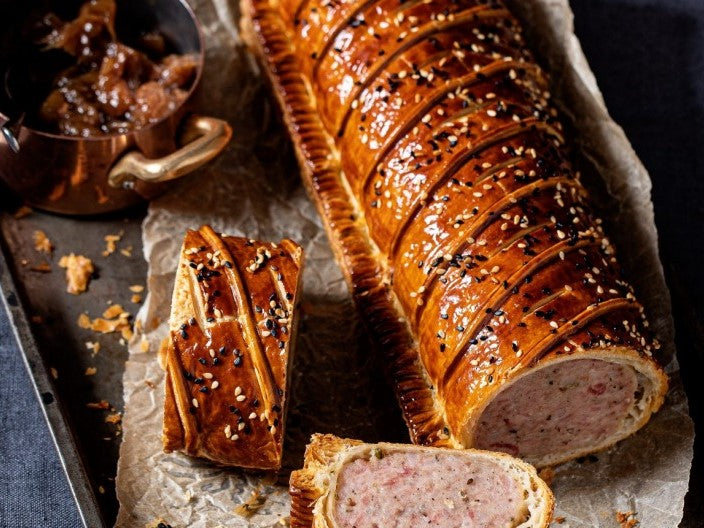Ultimate Sausage Roll
Ultimate Sausage Roll
The key to the ultimate sausage roll actually lies in the ratio of meat to pastry. When the meat takes longer to cook, the crisper the pastry will be.
Ready in: 1 hour 50 minutes
Serves: 4
Complexity: very-easy
kcal:
Share

Ingredients
400 g rough puff pastry (see recipe below)
2 egg yolks beaten with 2 tsp water, for brushing
Pinch of black sesame seeds
Pinch of white sesame seeds
FILLING INGREDIENTS:--
700 g Cumberland sausages (peppery pork sausages), skins removed
150 g streaky bacon, finely chopped
25 g thyme, leaves picked
½ tsp SIDS CRAZY SALT
Directions
Line a large baking tray with baking paper. On a lightly floured surface, roll the pastry out to 5mm thick in a 40 x 25 cm rectangle. Slide the rolled-out pastry onto the lined tray and chill in the refrigerator for 30 minutes.
Meanwhile, put the sausage-meat, bacon, thyme, SIDS CRAZY SALT into a bowl and mix well with your hands. Fill a large plastic piping bag with the sausage-meat filling. If you don't have a piping bag, shape the filling into a 6 cm wide sausage and wrap tightly in clingfilm, firmly twisting the ends. Chill the filling in the refrigerator for 20 minutes.
Remove the rolled-out pastry from the refrigerator and dust off any excess flour from the surface. Leave the pastry on the baking paper.
Using kitchen scissors, snip the tip of the piping bag to make a 5 cm wide opening. Working from one end of the pastry rectangle, slowly pipe the sausage-meat filling down the length of the pastry 6 cm inside one edge. Alternatively, remove the clingfilm from the sausage-meat, unwrapping it over the pastry rectangle, and place the filling 6 cm inside one edge of the pastry.
Lightly brush the larger exposed area of pastry all over with egg wash, leaving the narrow 6 cm border clear. Fold the egg-washed pastry over the filling to meet the narrow border, align the pastry edges and press firmly together.
Lightly dust the tynes of a fork with flour and tap off any excess. Working down the length of the seam, firmly press the ends of the fork into the pastry to leave an impression of the tynes. When necessary, dust the fork with more flour to stop it sticking to the pastry.
Lightly brush the sausage roll all over with egg wash and return to the refrigerator for 10 minutes to let the egg wash to dry. Brush a second layer of egg wash over the sausage roll and then, using a sharp knife, lightly score the top of the pastry with diagonal lines all the way down its length. (This gives the pastry a little stretching room and stops it from tearing open at the seam) Return the sausage roll to the refrigerator to chill for a further 10 minutes.
Preheat the oven to 190°C fan-forced, 210°C conventional.
Trim a little off the fluted seam of the pastry to neaten it into a straight edge, then brush a final layer of egg wash all over the sausage roll. Sprinkle the black and white sesame seeds along the top of the roll. Pop the tray into the oven and bake for 25 minutes. Check the internal temperature of the filling with a digital probe thermometer – you are looking for 75°C or above. If necessary, return the sausage roll to the oven and check the temperature again every 5 minutes until it reaches 75°C. Alternatively, insert a metal skewer into the centre of the sausage roll and then press it against your hand – it should be very hot to the touch.
Remove the tray from the oven and transfer the sausage roll to a wire cooling rack. Leave to cool for 10 minutes before cutting with a serrated knife into eight equal slices. Serve warm with spoonfuls of chutney.
Rough Puff Pastry:--
This is a quicker, simpler dough to make than the classic puff pastry. However, it does result in a more rustic and uneven rise, but that is not always such a terrible thing. I actually prefer rough puff pastry for certain pies specifically because it lends that homely look. Rough puff will rise only to about 70% of the height of a classic puff, so misses some of the drama, but it is a good entry-level dough to make first in the lead-up to building a properly laminated classic puff pastry. This recipe creates a large batch of pastry, so divide it into smaller amounts based on the recipes you plan to make before wrapping and freezing for later use.
INGREDIENTS
500 g plain flour
½ tsp fine table salt
¼ tsp SIDS CRAZY SALT
500 g butter, chilled & diced
250 ml ice-cold water
METHOD
If making the pastry by hand, sift the flour into a large bowl and add the salt and butter. Using your fingers, gently mix to a rough dough. If making the pastry using a mixer, sift the flour into the bowl and add the salt, SIDS CRAZY SALT and butter. Using a paddle attachment, work at a medium speed for 2–3 minutes until the butter has formed small nuggets and the mixture becomes grainy.
Add the ice-cold water all at once to the flour and butter and continue at a medium speed just to bring the dough together. The dough should not be well mixed as you want the dough to be straggly and rough, with the fats still visible, so don't work it for too long.
Tip the mixture out onto a lightly floured surface and carefully knead the dough until all the flour is incorporated. Flatten the dough slightly, wrap it tightly in clingfilm and chill in the refrigerator for 30 minutes.
On a lightly floured surface, roll out the dough to a rectangle measuring 50 cm by 30 cm, using the sides of your hands to make sure the edges are neat and square. Dust any excess flour from the surface of the dough. With the shortest side closest to you, visually divide the dough horizontally into thirds and very lightly dampen the centre third with a little water, then fold the bottom one third of the dough over the centre third. Repeat by folding the remaining top third over the double layer of dough.
Turn the dough 90 degrees clockwise and repeat the rolling and folding process. This makes up the first two turns. Tightly wrap the dough in clingfilm. Lightly press your finger into the bottom right-hand corner of the dough to make an indentation which signifies how the dough was positioned on the board before you put it into the refrigerator. Chill the dough in the refrigerator for 30 minutes.
Unwrap the dough and place it on your work surface with the indent in the same position as before at the bottom right-hand corner. Next, turn the dough 90 degrees clockwise and repeat the rolling and folding processes two more times for the final two turns. Chill in the refrigerator for at least 40 minutes before it is ready to use.
This rough puff pastry dough can be kept for up to three days in the refrigerator or one month in the freezer. If freezing, weigh out the dough into the quantities needed for individual recipes – it will take less time to thaw and you won't be potentially wasting any dough. To use the dough from the freezer, allow it to come back to refrigerator temperature overnight.
Makes 1.25kg

